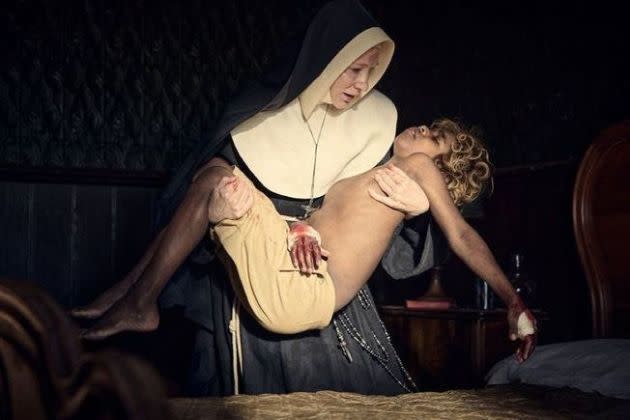‘The New Boy’ Review: Cate Blanchett In Warwick Thornton’s Version Of Australia’s Founding Story – Cannes Film Festival

Warwick Thornton is a master maker of images. The first frames of The New Boy – a sweep of dusty ground; a flash of a small boy on a policeman’s back, strangling him; a pre-war telegraph pole, all drenched in the searing white midday light of the desert – create a collage of inland Australia, a world of open spaces. The boy is duly pulled off of the policeman, put in a sack and delivered in the dark to a mission; a nun opens the door to receive the delivery. At that point, the gallery of Thornton’s frame becomes a series of golden brown interiors that could have come from Rembrandt, except that they are peopled with Indigenous boys – Lost Boys, as Sister Eileen (Cate Blanchett) describes them to God – and the trio of adults who look after them.
Out in the world, their compatriots are embroiled in the Second World War. Here in the mission for Lost Boys, life has its own logic, rhythms and a kind of purity. Thornton’s eye can find the beauty in a window frame. He is also telling — without stridency and with broad compassion for all his characters, all of them broken in their own way — a version of Australia’s founding story.
More from Deadline
From white folks’ point of view, the New Boy (Aswan Reid, a largely wordless but electric presence) is simply feral. George (Wayne Blair), the mission’s laconic Aboriginal handyman, says darkly that he knows what that boy is. We never really do. We just see a small, slight, elfin lad who sleeps on the ground and can catch snakes in his hands. He can also hit his fellows with a strength that seems superhuman, can calm another boy’s fever with his breath and has a strange ability to generate a darting light with a snap of his fingers. His sheer otherness lies beyond the compass of Sister Eileen’s pragmatic faith, a working muscle exercised as love for the boys in her charge and a tremendous ability to get things done.
One thing she has done is take over. Dom Peter is the titular head, but he has been dead for a year; Sister Eileen and Indigenous nun Sister Mum (Deborah Mailman) laugh over their late-night snifters as they remember wiping his bottom while he swore at them in his last wretched months. When he went, they just didn’t tell anyone. Sister Eileen, easily convinced by her own success that God must approve, presides over services, lies to anyone who asks for their old boss and then confesses her sins to the chair where he once sat: job done.
RELATED: Cannes Film Festival 2023 In Photos
George isn’t going to betray her. “I’m on a good wicket here,” he tells the New Boy, sharing a smidgeon of his private stash of marmalade. “Don’t stuff it up for me.” Neither will Sister Mum, who cooks, scolds and loves the boys who have no mother – or no acknowledged mother – of their own. A photograph of her own children sits by her bed, where she can weep over it in private. Mailman, always an actor of tremendous warmth, is heart-breaking here.
But Sister Eileen is also a woman of a strong, straightforward belief. When she finds the New Boy seems to have developed stigmata, however obviously self-administered in a show of empathy with the crucified Christ hanging on the wall of their chapel, she is confused, thrilled, overwhelmed and somehow angry. She ordered the Crucifix herself and was beyond excited when it arrived, telling the boys shyly that some people claimed it could work miracles. She longs for a miracle. But does anyone really want to deal with miracles, let alone a Second Coming? What she really wants is to get in the olive harvest. This muddle of conflicting emotions is right in Blanchett’s wheelhouse; we feel her torment, even if neither we nor she can exactly put a name on it, because her body twists and hunches to tell the story. For a woman who has given herself to the Lord, Sister Eileen is vigorously physical. Her history is written on her body.
In this crucible, Thornton plays out the conflict of two spiritualities as well as two ways of life, embodied in this sliver of a boy. This is not just a film about a boy with magical fingers. Nor is it a film for people who cringe at the mention of religion or who regard faith in a god as risible; the film is not a declaration of belief, but it does take belief seriously. With few words, Thornton layers complex metaphysical ideas that can never be resolved.
The New Boy sees the eyes of the statue blink and, somehow, Sister Eileen knows he sees something. One night, she finds him halfway up the Crucifix, clinging to the wooden figure in a koala hug. She has seen him do the same to a tree. How can it be that his punctured hands heal inexplicably overnight?
As a Catholic, she believes in a supernatural world: “All things visible and invisible,” as the Creed says. Just not these invisible things: they don’t belong here. Except, of course, that they are what truly belong, embedded in the land and its people. It is the Australian tragedy – the tragedy of all conquered Indigenous peoples – brought to life in miniature against the divine backdrop of this dry, glorious country.
Title: The New Boy
Festival: Cannes (Un Certain Regard)
Director-screenwriter: Warwick Thornton
Cast: Aswan Reid, Cate Blanchett, Deborah Mailman, Wayne Blair
Running time: 1 hr 56 min
Sales agent: The Veterans
Best of Deadline
Sign up for Deadline's Newsletter. For the latest news, follow us on Facebook, Twitter, and Instagram.

